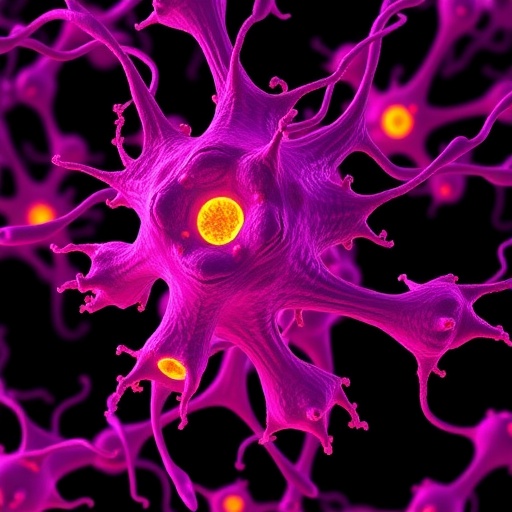In the rapidly evolving field of cellular biology, the advent of single-cell RNA sequencing (scRNA-seq) has heralded a transformative era. This groundbreaking technology permits scientists to decode the gene expression profiles of individual cells, illuminating the molecular underpinnings that drive cellular function and diversity. Yet, despite its immense utility, scRNA-seq inherently involves dissociating cells from their tissue environment, obliterating crucial spatial context—a dimension that holds vital clues about cellular interactions and tissue architecture. This spatial information, integral for understanding how cells communicate and organize within organs, has long remained elusive.
Spatial transcriptomics has emerged as a complementary approach, preserving the spatial arrangements of cells within tissue sections while profiling gene expression. However, this methodology carries formidable technical challenges, including lower throughput and restricted scalability, which have hampered its widespread adoption. The scientific community has grappled with a persistent dilemma: how to integrate the rich, positional context of spatial data with the high-resolution, high-throughput insights of dissociated single-cell data to achieve a holistic understanding of tissue biology.
Addressing this scientific impasse, a pioneering research consortium has unveiled Nicheformer, a novel artificial intelligence foundation model that deftly bridges the gap between dissociated and spatial cellular data. By leveraging an unprecedented integrative dataset named SpatialCorpus-110M—comprising over 110 million meticulously curated cellular profiles drawn from both single-cell sequencing and spatial transcriptomics—Nicheformer is capable of inferring the spatial context of cells analyzed in isolation. In essence, this model can retroactively “reposition” dissociated cells within their native tissue architecture, reconstructing their microenvironment and providing insights into spatial gene expression patterns that were previously obscured.
At the core of Nicheformer’s success lies its ability to detect subtle residual imprints of spatial information encoded indirectly in gene expression profiles. Even after cells are dissociated, patterns reflective of their original neighbors and microenvironments persist within their transcriptomes. Through sophisticated machine learning architecture and training regimens, Nicheformer learns to decode these latent signals, rendering an approximate map of cellular organization. This capability surpasses that of existing methods, offering a scalable solution to a longstanding bottleneck in tissue biology.
Importantly, the researchers have not only demonstrated Nicheformer’s superior predictive performance but also delved into the interpretability of its learned representations. By probing the internal neural layers, they revealed that the model encapsulates biologically meaningful features correlating with known tissue structures and cellular niches. This dual emphasis on accuracy and transparency marks a significant leap forward, fostering confidence in the utility of AI-driven approaches within the mechanistic exploration of biological systems.
The conceptual leap made by Nicheformer aligns with burgeoning initiatives aimed at constructing a “Virtual Cell”—a comprehensive, computational representation capturing the behavior and interactions of cells as they exist in vivo. Prior models frequently treated cells as discrete, context-free entities, limiting their capacity to model intricate spatial dependencies critical for tissue function and disease progression. Nicheformer represents the first foundation model explicitly designed to ingest and learn from spatial organization directly, empowering unprecedented insights into how cells sense, respond to, and influence their neighbors.
Beyond its immediate technical achievements, this model sets the stage for a suite of rigorous spatial benchmarks, challenging the next generation of computational frameworks to capture the complexity of tissue architecture and collective cellular behaviors. These benchmarks are critical stepping stones toward the realization of biologically realistic AI systems capable of informing experimental design and therapeutic strategies.
The implications of this work extend deeply into biomedical research landscapes. By enabling large-scale, cost-effective spatial annotation of dissociated single-cell datasets, Nicheformer offers a powerful tool for dissecting cellular heterogeneity and neighborhood dynamics in healthy and diseased tissues. Researchers can now explore tissue organization without the need for additional spatial assays, accelerating discoveries in developmental biology, immunology, oncology, and beyond.
Looking forward, the research team envisions advancing toward the creation of a comprehensive “tissue foundation model” that not only integrates spatial transcriptomics but also learns the physical and mechanical relationships between cells. Such innovation holds promise for unraveling the complexities of tumor microenvironments, inflammatory niches, and other multifaceted biological systems with profound clinical relevance. This trajectory aligns with the broader quest to harness computational models for precision medicine, where understanding the cellular milieu is paramount for targeted interventions.
Dr. Alejandro Tejada-Lapuerta, co-first author of the study, emphasizes that Nicheformer’s ability to transfer spatial information represents a crucial first step toward more generalizable AI models that faithfully represent cells in their native context. This paradigm shift is expected to revolutionize experimental biology by merging computational and experimental modalities, ultimately fueling breakthroughs in understanding tissue physiology and pathology.
Prof. Fabian Theis, a leading figure in computational biology and co-author, underscores the transformative potential of integrating AI with spatial biology. His vision anticipates that foundational models like Nicheformer will not only deepen scientific understanding but also guide the development of novel therapies by accurately modeling cellular environments at unprecedented resolution.
Helmholtz Munich, the research hub behind this innovation, stands at the forefront of biomedical research, integrating artificial intelligence and bioengineering to tackle pressing health challenges such as diabetes, obesity, and chronic inflammatory diseases. Their interdisciplinary approach embodies a new era in biomedical sciences, where data-driven methodologies complement traditional experimental paradigms to generate holistic insights into human health.
As the field of spatial biology continues to accelerate, the emergence of integrative AI models such as Nicheformer marks a watershed moment—a convergence of technology and biology that promises to unravel the complexities of tissues at a scale and precision previously unimaginable. This synergy offers the tantalizing prospect of a future where virtual tissue models guide personalized medicine, ushering in transformative advances in diagnosis, treatment, and prevention of diseases.
Subject of Research: Artificial intelligence integration of single-cell and spatial transcriptomics data to reconstruct tissue architecture and cellular microenvironments.
Article Title: Toward a Virtual Cell: Nicheformer Enables Spatial Context Reconstruction in Single-Cell Data
News Publication Date: 30-Oct-2025
Web References: http://dx.doi.org/10.1038/s41592-025-02814-z
References: Nature Methods, 10.1038/s41592-025-02814-z
Image Credits: Helmholtz Munich / Alejandro Tejada-Lapuerta / Anna C. Schaar
Keywords: Cell behavior, Computational biology, Single-cell RNA sequencing, Spatial transcriptomics, Tissue organization, Artificial intelligence, Virtual Cell




